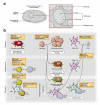The spleen in local and systemic regulation of immunity
- PMID: 24238338
- PMCID: PMC3912742
- DOI: 10.1016/j.immuni.2013.10.010
The spleen in local and systemic regulation of immunity
Erratum in
-
The Spleen in Local and Systemic Regulation of Immunity.Immunity. 2023 May 9;56(5):1152. doi: 10.1016/j.immuni.2023.04.004. Immunity. 2023. PMID: 37163985 No abstract available.
Abstract
The spleen is the main filter for blood-borne pathogens and antigens, as well as a key organ for iron metabolism and erythrocyte homeostasis. Also, immune and hematopoietic functions have been recently unveiled for the mouse spleen, suggesting additional roles for this secondary lymphoid organ. Here we discuss the integration of the spleen in the regulation of immune responses locally and in the whole body and present the relevance of findings for our understanding of inflammatory and degenerative diseases and their treatments. We consider whether equivalent activities in humans are known, as well as initial therapeutic attempts to target the spleen for modulating innate and adaptive immunity.
Copyright © 2013 Elsevier Inc. All rights reserved.
Figures



References
-
- Amlot PL, Hayes AE. Impaired human antibody response to the thymus-independent antigen, DNP-Ficoll, after splenectomy. Implications for post-splenectomy infections. Lancet. 1985;1:1008–1011. - PubMed
-
- Ansel KM, Ngo VN, Hyman PL, Luther SA, Forster R, Sedgwick JD, Browning JL, Lipp M, Cyster JG. A chemokine-driven positive feedback loop organizes lymphoid follicles. Nature. 2000;406:309–314. - PubMed
Publication types
MeSH terms
Substances
Grants and funding
LinkOut - more resources
Full Text Sources
Other Literature Sources

